Music Recording Producer Business Plan
Mt. Hood Records is a sustainable record label founded by Hillary MacQuilliams in Oregon. The company promotes Portland-based bands that share the element of improvisation.
The retail record industry is dominated by a few large corporations that control over 87% of CD sales in the country. Indie record labels, comprising 8% of sales, offer a less commercial alternative. The remaining 5% consists of various record labels. Most labels take a shot gun approach to sales, signing up numerous bands and hoping for a few major successes. Record corporations profit greatly from commercially successful bands. Indie labels follow a similar model, although they are more selective and do not solely prioritize commercial viability.
Products and Services:
Mt. Hood Records is a record label for a select group of Portland-based bands. The label focuses on signing just a few bands and promoting them equally, rather than relying on one band’s success to support others. This approach appeals to bands that want a specialized, intimate partnership with a label that prioritizes their promotion and ensures they won’t be lost in the shuffle.
The Business Model:
In order for this label to succeed, there will be little to no revenue stream for the first year, requiring significant effort and dedication. Mt. Hood Records has established realistic expectations from the beginning and received support from investors (friends and family) who are aware of these parameters. While it will be challenging, with upfront expectations and effective management, success is achievable.
Management:
Hillary MacQuilliams, a veteran of the music industry, founded and manages Mt. Hood Records. After college, Hillary went on tour with her own band and started a record label to release their own studio CD. While that experience was more of a novelty than a serious attempt at running a label, it sparked Hillary’s passion for music. After law school, Hillary decided to pursue a career in the music industry and developed a sustainable business model for a local, exclusive record label, which became Mt. Hood Records.
1.1 Objectives
- Become the premier local music label based on CD sales within three years.
- Sign at least five groups within the first three years.
- Achieve profitability within three years.
1.2 Mission
Mt. Hood Records exists as a locally based record label that promotes local music groups, increasing their live appearances and record sales. The label aims to make a fair profit while supporting its bands.
1.3 Keys to Success
- Choose promising bands for promotion.
- Avoid signing too many bands to maintain effective promotion.
- Work hard and enjoy the process.
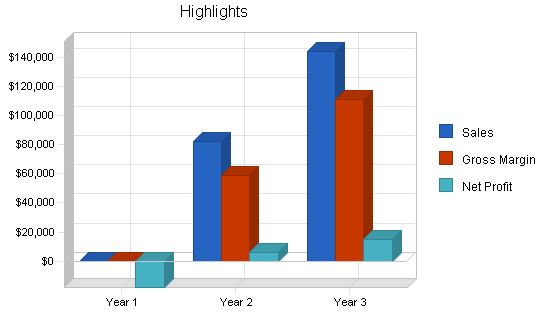
Company Summary
Mt. Hood Records is a start-up organization founded as an Oregon-based L.L.C. It was established in January 2003 by Hillary MacQuilliams.
2.1 Company Ownership
The company is primarily owned by Hillary MacQuilliams. She has invested personal funds in the business and will seek additional investment from friends and family.
2.2 Start-up Summary
Mt. Hood Records will purchase the following equipment for the start-up phase:
- Laptop computer
- Various printed material
During the first year, Mt. Hood Records will operate with low overhead and no revenue. The owner’s investment and funds from friends and family will be relied upon since securing bank debt is difficult without immediate revenue. Hillary will not take a salary for the first two years since unfamiliar investors or bank debt typically require a salary for the principal. Instead, she will be making sweat equity investments during the first year.
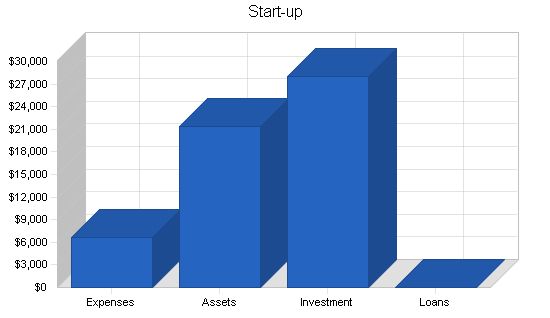
Start-up Expenses
Legal: $0
Stationery etc.: $0
Brochures: $500
Website development: $6,000
Insurance: $0
Rent: $150
Research and Development: $0
Expensed Equipment: $0
Other: $0
Total Start-up Expenses: $6,650
Start-up Assets
Cash Required: $19,350
Start-up Inventory: $0
Other Current Assets: $0
Long-term Assets: $2,000
Total Assets: $21,350
Total Requirements: $28,000
Start-up Funding
Start-up Expenses to Fund: $6,650
Start-up Assets to Fund: $21,350
Total Funding Required: $28,000
Assets
Non-cash Assets from Start-up: $2,000
Cash Requirements from Start-up: $19,350
Additional Cash Raised: $0
Cash Balance on Starting Date: $19,350
Total Assets: $21,350
Liabilities and Capital
Liabilities
Current Borrowing: $0
Long-term Liabilities: $0
Accounts Payable (Outstanding Bills): $0
Other Current Liabilities (interest-free): $0
Total Liabilities: $0
Capital
Planned Investment
Hillary MacQuilliams: $10,000
Family and Friends: $18,000
Other: $0
Additional Investment Requirement: $0
Total Planned Investment: $28,000
Loss at Start-up (Start-up Expenses): ($6,650)
Total Capital: $21,350
Total Capital and Liabilities: $21,350
Total Funding: $28,000
Products and Services
Mt. Hood Records is a new record label based in Portland, Oregon. It takes an unusual approach to band promotion and CD sales. Instead of competing with national record labels and larger Indie labels, Mt. Hood Records focuses on local bands, offering specialized and attentive service. This unique approach sets it apart from other record labels.
Operations begin with the production of a compilation CD featuring local artists. Bands are encouraged to place a single on the CD for visibility. This helps them gain recognition and secure live gigs and CD sales. Within the first year, two compilation CDs are produced, which are distributed for free. As the CDs promote the bands, they also promote Mt. Hood Records, establishing it as a hardworking and dedicated label.
Mt. Hood Records also engages in networking with local radio stations, record stores, and clubs to get airplay, sell CDs, and secure live gigs for the bands. The label aims to be well-known locally and attract local acts looking to join a record label. By working with a maximum of five bands at a time, Mt. Hood Records provides specialized and intimate promotional assistance.
Once the bands sign on, Mt. Hood Records helps them produce studio CDs, focusing on record sales and live show production for revenue generation. The label expects little to no revenue in the first year as it builds its reputation. Mt. Hood Records does not limit itself to a specific genre of music, choosing instead to focus on the element of improvisation found in various genres. Improvisation brings spontaneity and experimentation to performances, allowing bands to shine, entertain, and engage audiences.
Market Analysis Summary
Mt. Hood Records targets two primary market segments: record stores and consumers at live shows. These segments are the main sources of income for the label. Initially, Mt. Hood Records focuses on developing visibility within the community to attract bands, which are key to revenue generation. Marketing activities are geared towards signing up bands and generating future revenue.
Market Segmentation
Mt. Hood Records has identified two target market segments:
1. Record retailers: This segment sells CDs to end consumers. It takes time for record stores to move a decent quantity of CDs, as bands need to establish themselves through the compilation CD release and live performances. This segment will be used to sell the compilation CD and band CDs in the future.
2. Consumers at live concerts: This segment attends local music performances and often purchases CDs of the bands they are watching. This is typically an impulse purchase driven by their enjoyment of the music. Patrons also purchase the compilation CD to discover new music.
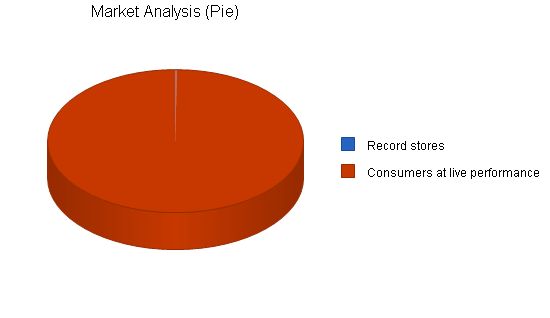
Market Analysis
Table: Year 1 Year 2 Year 3 Year 4 Year 5
Potential Customers Growth CAGR
Record stores 23 24 25 26 27 4.09%
Consumers at live performances 18,776 20,090 21,496 23,001 24,611 7.00%
Total 18,799 20,114 21,521 23,027 24,638 7.00%
4.2 Target Market Segment Strategy
Mt. Hood Records focuses on two market segments – record stores and consumers at live performances. Networking is the most efficient and effective way to gain access to record stores and generate potential record sales.
Another source of revenue is the buyout of bands from their Mt. Hood contract by larger national labels. These events occur independently but are tracked in the sales forecasts.
4.3 Service Business Analysis
The record industry is highly concentrated, with international corporations controlling the majority of sales. Indie labels are broader, supporting national acts in less commercial ways. Local record labels focus on regional musicians with day jobs. Mt. Hood Records aims to concentrate on a specific region for viability.
4.3.1 Competition and Buying Patterns
– National record labels (e.g., Atlantic, Sony, BMG) focus on CD sales and mass appeal.
– Indie labels exploit niche markets with less commercial means.
– Regional labels vary in their approach, some focusing on a band’s health and popularity, while others represent multiple bands without much care.
Strategy and Implementation Summary
Mt. Hood Records differentiates itself through low overhead and a low band count. Their office is based at the owner’s home, and they save costs by renting studio time as needed. With fewer bands, Mt. Hood Records can provide specialized care and attention, offering better plugging and placement. This approach is similar to the athlete representation field, where intimate care yields better results.
5.1 Competitive Edge
Mt. Hood Records’ competitive edge lies in low overhead and a low band count. By operating from a home office, they save costs on rent and studio time. With fewer bands, they can offer specialized care and achieve better results. This differs from the industry norm of representing many athletes, as seen in the cyclist representation field.
Mt. Hood Records’ reputation within the music community is vital. They aim to become a premier label through networking and the release of compilation CDs. Live shows and networking contacts are crucial for marketing their bands. Other activities include calling up newspapers, submitting press releases, finding good story angles, listing shows, coddling radio stations, developing press kits, and obtaining professional photos.
5.3 Sales Strategy
Mt. Hood Records’ sales strategy focuses on record retailers and consumers at shows. They negotiate agreements with retailers, offering a unique arrangement where unsold CDs can be returned for credit. They also sell CDs at live performances, leveraging their positive reputation and the common element of improvisation their label represents.
5.3.1 Sales Forecast
Sales will be slow initially, with the first two compilation CDs given out for free. By the third compilation, revenue-generating CD sales will begin as bands are signed. Online website sales will also contribute to revenue. Contract buyouts from larger record labels and direct revenue from CD sales at shows are additional sources of income.
Direct costs of goods include studio time, mastering and mixing expenses, intellectual property costs, CD production, and distribution expenses.
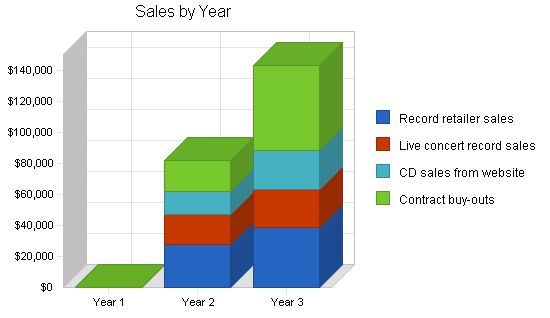
Sales Forecast
| Sales Forecast | |||
| Year 1 | Year 2 | Year 3 | |
| Sales | |||
| Record retailer sales | $0 | $28,090 | $39,076 |
| Live concert record sales | $0 | $19,000 | $24,090 |
| CD sales from website | $0 | $15,070 | $25,600 |
| Contract buy-outs | $0 | $20,000 | $55,000 |
| Total Sales | $0 | $82,160 | $143,766 |
| Direct Cost of Sales | Year 1 | Year 2 | Year 3 |
| Record retailer sales | $0 | $11,236 | $15,630 |
| Live concert record sales | $0 | $6,650 | $8,432 |
| CD sales from website | $0 | $5,275 | $8,960 |
| Contract buy-outs | $0 | $0 | $0 |
| Subtotal Direct Cost of Sales | $0 | $23,161 | $33,022 |
5.4 Milestones
Several milestones have been established as goals and tracking mechanisms. While the milestones are initially static, they can be dynamic if needed. Please see the table below for details regarding the milestones.
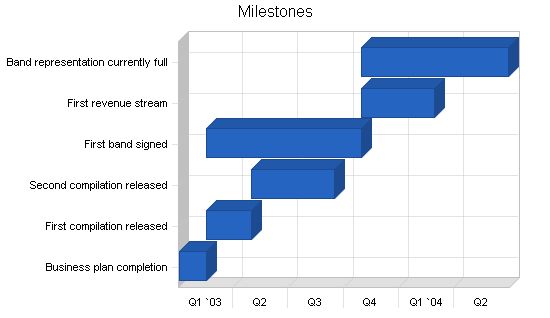
Milestones:
– Business plan completion: 1/1/2003 – 2/15/2003, $0 budget, Manager: Hillary, Department: Business Development
– First compilation released: 2/15/2003 – 5/1/2003, $0 budget, Manager: Hillary, Department: Marketing
– Second compilation released: 5/1/2003 – 9/15/2003, $0 budget, Manager: Hillary, Department: Marketing
– First band signed: 2/15/2003 – 10/30/2003, $0 budget, Manager: Hillary, Department: Sales
– First revenue stream: 10/30/2003 – 2/28/2004, $0 budget, Manager: Hillary, Department: Sales
– Band representation currently full: 10/30/2003 – 6/30/2004, $0 budget, Manager: Hillary, Department: Sales
– Totals: $0 budget
Web Plan Summary:
Mt. Hood Records’ website will be an excellent source of information dissemination and CD sales. The different bands will be listed with information about their music, bios, etc. Music samples of the bands will also be available as streaming media and compressed downloads. Touring dates will be posted to encourage attendance. CDs will be sold on the website, and the e-commerce module will be outsourced.
Website Marketing Strategy:
The site will be linked to Portland entertainment guides and submitted to search engines. The URL address will be included on all printed material and correspondence.
Development Requirements:
The site will be developed by a computer science student.
Management Summary:
Hillary MacQuilliams started her music career after college, forming her own record label with her bandmates of 180 South. The label was created to support a regional tour and self-promotion. Hillary earned a J.D. degree and decided to start another record label, leveraging her passion for music. She planned to rely on her husband’s income and keep overhead low for the first year.
Personnel Plan:
Hillary will be the primary employee. She will work long hours, often with her husband’s help. They will not take a salary for the first two years. Two additional employees will be hired, one for sales and one for distribution.
Sales position: This position will sell CDs at concerts.
Distribution position: This position will be responsible for distributing the CDs to retailers.
Personnel Plan:
– Hillary: Year 1: $0, Year 2: $0, Year 3: $30,000
– Sales: Year 1: $0, Year 2: $12,000, Year 3: $13,000
– Distribution: Year 1: $1,600, Year 2: $12,000, Year 3: $13,000
– Total People: Year 1: 1, Year 2: 3, Year 3: 3
– Total Payroll: Year 1: $1,600, Year 2: $24,000, Year 3: $56,000
The following sections present important financial information.
Important Assumptions:
General Assumptions:
– Plan Month: Year 1: 1, Year 2: 2, Year 3: 3
– Current Interest Rate: 10.00%
– Long-term Interest Rate: 10.00%
– Tax Rate: 30.00%
– Other: 0
The analysis indicates the monthly revenue needed to break even.
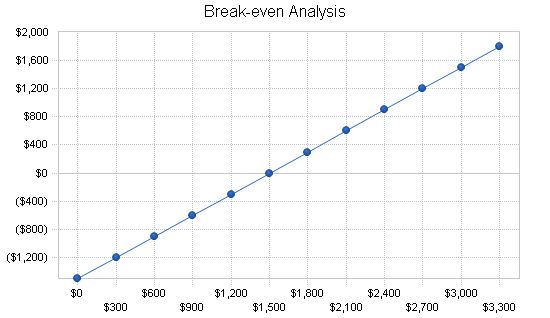
Break-even Analysis
Monthly Revenue Break-even: $1,502
Assumptions:
– Average Percent Variable Cost: 0%
– Estimated Monthly Fixed Cost: $1,502
8.3 Projected Profit and Loss
The following table and charts illustrate projected profit and loss.
Explanations for some line items:
Sales and Marketing: The compilation CDs will be used for marketing purposes to develop visibility for Mt. Hood Records as a record label. This will assist in introducing up and coming bands to Mt. Hood Records. Once the bands have been signed to exclusive contracts by Mt. Hood Records, they will be the only bands on the compilation CDs. Mt. Hood Records will outsource activities such as mixing, mastering, CD production, and artwork/barcode expenses to keep capital expenditures low. Expenses related to the cost of production of the compilation included in the sales and marketing costs are:
– Initial studio recording time
– Mixing, mastering expenses
– CD label costs (artwork, barcode, etc.)
– Promotional CDs given out.
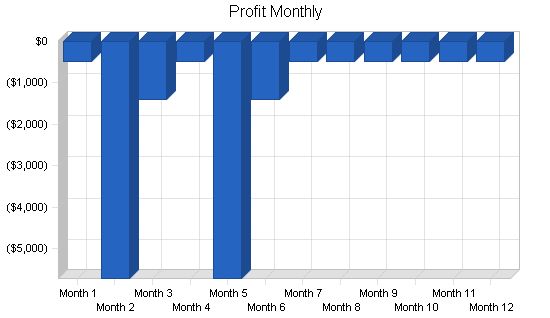
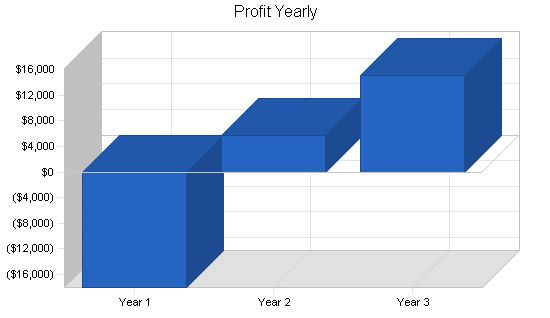
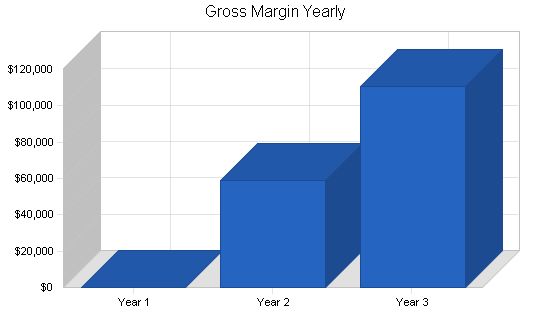
Pro Forma Profit and Loss:
| Profit and Loss | |||
| Year 1 | Year 2 | Year 3 | |
| Sales | $0 | $82,160 | $143,766 |
| Direct Cost of Sales | $0 | $23,161 | $33,022 |
| Other Costs of Goods | $0 | $0 | $0 |
| Total Cost of Sales | $0 | $23,161 | $33,022 |
| Gross Margin | $0 | $59,000 | $110,744 |
| Gross Margin % | 0.00% | 71.81% | 77.03% |
| … | |||
8.4 Projected Cash Flow
The following chart and table show the projected cash flow.
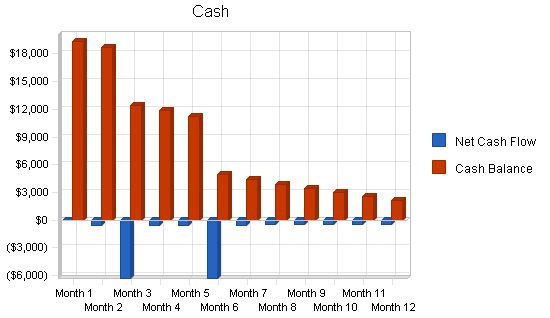
Pro Forma Cash Flow
| Year 1 | Year 2 | Year 3 | |
| Cash Sales | $0 | $20,540 | $35,942 |
| Cash from Receivables | $0 | $61,620 | $107,825 |
| Subtotal Cash from Operations | $0 | $82,160 | $143,766 |
| Sales Tax, VAT, HST/GST Received | $0 | $0 | $0 |
| New Current Borrowing | $0 | $0 | $0 |
| New Other Liabilities (interest-free) | $0 | $0 | $0 |
| New Long-term Liabilities | $0 | $0 | $0 |
| Sales of Other Current Assets | $0 | $0 | $0 |
| Sales of Long-term Assets | $0 | $0 | $0 |
| New Investment Received | $0 | $0 | $0 |
| Subtotal Cash Received | $0 | $82,160 | $143,766 |
| Expenditures | Year 1 | Year 2 | Year 3 |
| Cash Spending | $1,600 | $24,000 | $56,000 |
| Bill Payments | $15,595 | $48,234 | $70,690 |
| Subtotal Spent on Operations | $17,195 | $72,234 | $126,690 |
| Net Cash Flow | ($17,195) | $9,926 | $17,076 |
| Cash Balance | $2,155 | $12,081 | $29,158 |
8.5 Projected Balance Sheet
The following table presents the projected balance sheet.
| Year 1 | Year 2 | Year 3 | |
| Current Assets | |||
| Cash | $2,155 | $12,081 | $29,158 |
| Accounts Receivable | $0 | $0 | $0 |
| Inventory | $0 | $0 | $0 |
| Other Current Assets | $0 | $0 | $0 |
| Total Current Assets | $2,155 | $12,081 | $29,158 |
| Long-term Assets | |||
| Long-term Assets | $2,000 | $2,000 | $2,000 |
| Accumulated Depreciation | $400 | $800 | $1,200 |
| Total Long-term Assets | $1,600 | $1,200 | $800 |
| Total Assets | $3,756 | $13,281 | $29,958 |
| Current Liabilities | Year 1 | Year 2 | Year 3 |
| Accounts Payable | $425 | $4,281 | $5,947 |
| Current Borrowing | $0 | $0 | $0 |
| Other Current Liabilities | $0 | $0 | $0 |
| Total Current Liabilities | $425 | $4,281 | $5,947 |
| Long-term Liabilities | $0 | $0 | $0 |
| Total Liabilities | $425 | $4,281 | $5,947 |
| Paid-in Capital | $28,000 | $28,000 | $28,000 |
| Retained Earnings | ($6,650) | ($24,670) | ($19,000) |
| Earnings | ($18,020) | $5,670 | $15,011 |
| Total Capital | $3,330 | $9,000 | $24,011 |
| Total Liabilities and Capital | $3,756 | $13,281 | $29,958 |
| Net Worth | $3,330 | $9,000 | $24,011 |
8.6 Business Ratios
Business ratios for the years of this plan are shown below. Industry profile ratios based on the Music recording and distributing industry NAICS code 512220, are shown for comparison.
| Year 1 | Year 2 | Year 3 | Industry Profile | |
| Sales Growth | 0.00% | 0.00% | 74.98% | -22.55% |
| Percent of Total Assets | ||||
| Accounts Receivable | 0.00% | 0.00% | 0.00% | 16.48% |
| Inventory | 0.00% | 0.00% | 0.00% | 21.02% |
| Other Current Assets | 0.00% | 0.00% | 0.00% | 31.62% |
| Total Current Assets | 57.39% | 90.96% | 97.33% | 69.12% |
| Long-term Assets | 42.61% | 9.04% | 2.67% | 30.88% |
| Total Assets | 100.00% | 100.00% | 100.00% | 100.00% |
| Current Liabilities | ||||
| Accounts Payable | 11.32% | 32.24% | 19.85% | 25.08% |
| Long-term Liabilities | 0.00% | 0.00% | 0.00% | 16.76% |
| Total Liabilities | 11.32% | 32.24% | 19.85% | 41.84% |
| Net Worth | 88.68% | 67.76% | 80.15% | 58.16% |
| Percent of Sales | ||||
| Sales | 100.00% | 100.00% | 100.00% | 100.00% |
| Gross Margin | 0.00% | 71.81% | 77.03% | 29.18% |
| Selling, General & Administrative Expenses | 0.00% | 64.91% | 66.59% | 10.66% |
| Advertising Expenses | 0.00% | 0.00% | 0.00% | 0.44% |
| Profit Before Interest and Taxes | 0.00% | 9.86% | 14.92% | 5.25% |
| Main Ratios | ||||
| Current | 5.07 | 2.82 | 4.90 | 2.54 |
| Quick | 5.07 | 2.82 | 4.90 | 1.38 |
| Total Debt to Total Assets | 11.32% | 32.24% | 19.85% | 49.40% |
| Pre-tax Return on Net Worth | -541.06% | 89.99% | 89.31% | 6.25% |
| Pre-tax Return on Assets | -479.79% | 60.98% | 71.58% | 12.35% |
| Additional Ratios | Year 1 | Year 2 | Year 3 | |
|
Hillary: 0%, $0, $0, $0, $0, $0, $0, $0, $0, $0, $0, $0, $0 Sales: 0%, $0, $0, $0, $0, $0, $0, $0, $0, $0, $0, $0, $0 Distribution: 0%, $0, $0, $800, $0, $0, $800, $0, $0, $0, $0, $0, $0 Total People: 1, 1, 2, 1, 1, 2, 1, 1, 1, 1, 1, 1, 1 Total Payroll: $0, $0, $800, $0, $0, $800, $0, $0, $0, $0, $0, $0, $0 General Assumptions: Plan Month: 1, 2, 3, 4, 5, 6, 7, 8, 9, 10, 11, 12 Current Interest Rate: 10.00%, 10.00%, 10.00%, 10.00%, 10.00%, 10.00%, 10.00%, 10.00%, 10.00%, 10.00%, 10.00%, 10.00%, 10.00% Long-term Interest Rate: 10.00%, 10.00%, 10.00%, 10.00%, 10.00%, 10.00%, 10.00%, 10.00%, 10.00%, 10.00%, 10.00%, 10.00%, 10.00% Tax Rate: 30.00%, 30.00%, 30.00%, 30.00%, 30.00%, 30.00%, 30.00%, 30.00%, 30.00%, 30.00%, 30.00%, 30.00%, 30.00% Other: 0, 0, 0, 0, 0, 0, 0, 0, 0, 0, 0, 0, 0 Pro Forma Profit and Loss: Sales: $0, $0, $0, $0, $0, $0, $0, $0, $0, $0, $0, $0, $0 Direct Cost of Sales: $0, $0, $0, $0, $0, $0, $0, $0, $0, $0, $0, $0, $0 Other Costs of Goods: $0, $0, $0, $0, $0, $0, $0, $0, $0, $0, $0, $0, $0 Total Cost of Sales: $0, $0, $0, $0, $0, $0, $0, $0, $0, $0, $0, $0, $0 Gross Margin: $0, $0, $0, $0, $0, $0 Pro Forma Cash Flow: Cash Received Cash Sales $0 $0 $0 $0 $0 $0 $0 $0 $0 $0 $0 $0 Cash from Receivables $0 $0 $0 $0 $0 $0 $0 $0 $0 $0 $0 $0 Subtotal Cash from Operations $0 $0 $0 $0 $0 $0 $0 $0 $0 $0 $0 $0 Additional Cash Received $0 $0 $0 $0 $0 $0 $0 $0 $0 $0 $0 $0 Sales Tax, VAT, HST/GST Received 0.00% $0 $0 $0 $0 $0 $0 $0 $0 $0 $0 $0 $0 New Current Borrowing $0 $0 $0 $0 $0 $0 $0 $0 $0 $0 $0 $0 $0 New Other Liabilities (interest-free) $0 $0 $0 $0 $0 $0 $0 $0 $0 $0 $0 $0 $0 New Long-term Liabilities $0 $0 $0 $0 $0 $0 $0 $0 $0 $0 $0 $0 $0 Sales of Other Current Assets $0 $0 $0 $0 $0 $0 $0 $0 $0 $0 $0 $0 $0 Sales of Long-term Assets $0 $0 $0 $0 $0 $
Business Plan Outline
|
Hello!
I’m Andrew Brooks, a seasoned finance consultant from the USA and the mind behind phonenumber247.com.
My career is built on a foundation of helping individuals and businesses thrive financially in an ever-changing economic landscape. At phonenumber247.com, my aim is to demystify the complex world of finance, providing clear, actionable advice that can help you navigate your financial journey with confidence. Whether it’s personal finance management, investment strategies, or understanding the nuances of market dynamics, I’m here to share insights and tools that can propel you towards your financial goals.
Welcome to my digital space, where every piece of advice is a step closer to financial clarity and success!

